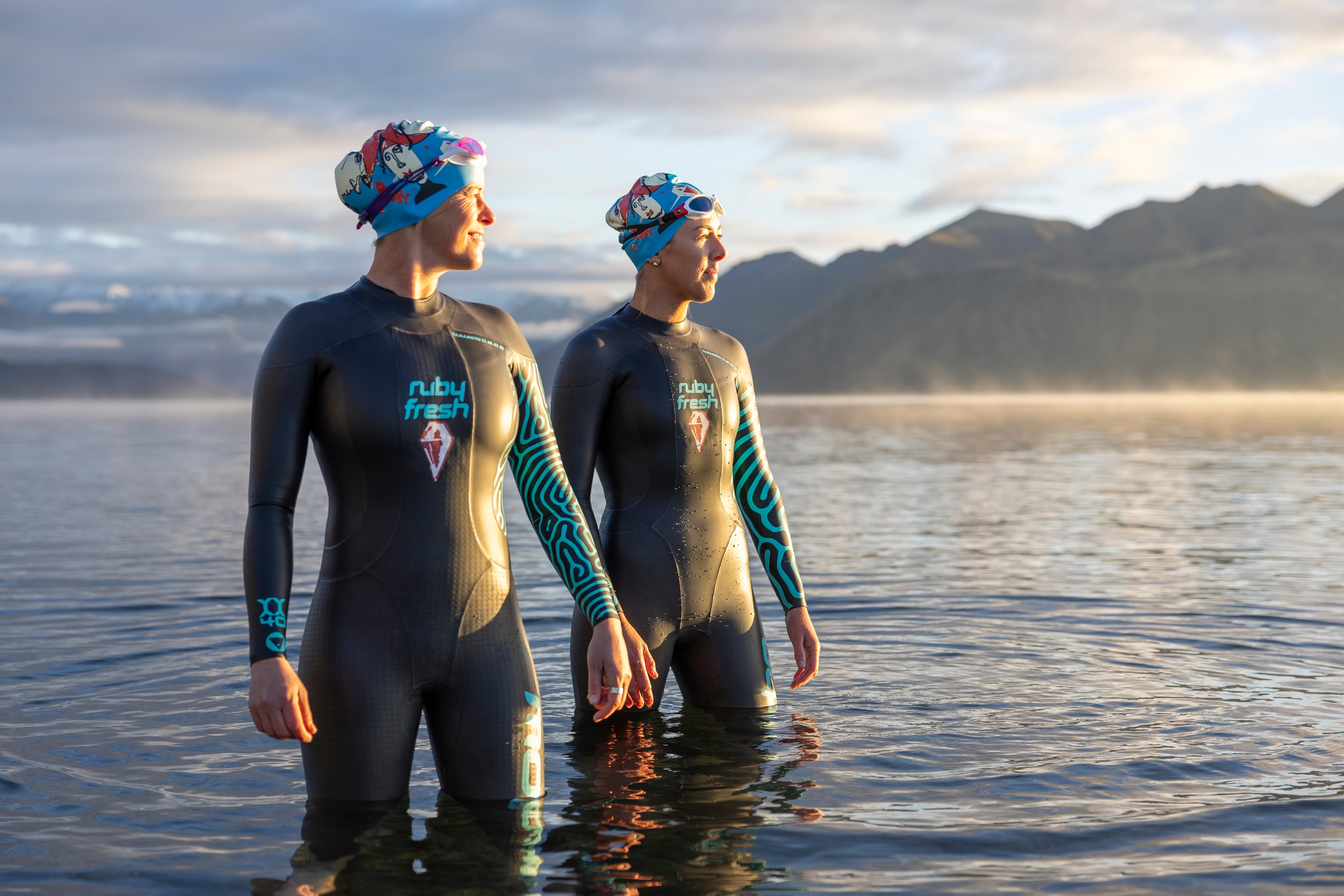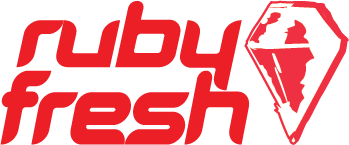The Flow & The Echo
What are the differences?
Which model is right for me?

Below is a comparison of the Ruby Fresh Flow and Echo wetsuits, focusing on buoyancy profiles, materials, and pricing.
Ruby Fresh Wetsuit Models Comparison (Flow vs. Echo)
-
Feature
Target Swimmer
-
Flow
All genders, suited for swimmers needing higher buoyancy (primary). More warmth (secondary)
-
Echo
All genders, suited for swimmers needing lower buoyancy
-
Buoyancy Profile
-
Higher buoyancy with thicker neoprene (5mm aerodome in legs/torso) for enhanced lift, ideal for swimmers needing support in freshwater.
-
Lower buoyancy with 4mm and 3mm Yamamoto neoprene panels, designed for proficient swimmers in fresh water or a neutral swim position in salt water.
-
Materials
-
Yamamoto SCS smooth-skin limestone neoprene 5mm Aerodome panels in key positions for added buoyancy. Arm and latissimus dorsi panels use Yamamoto #40 SCS limestone neoprene — 1.6mm. The most highly malleable and supple neoprene.
-
Yamamoto #39 & #38 SCS coated limestone neoprene (4mm and 3mm main panels), Arm and latissimus dorsi panels in 1.6mm less supple #39 grade neoprene.
-
Warmth
-
Higher thermal insulation from thicker 5mm Yamamoto Aerodome Buoyancy Tray™ panels and prodigious Titanium-Alpha membrane in torso, arms, and calf panels, ideal for colder waters.
-
Moderate thermal insulation from thinner 3-4mm panels but utilises the same Titanium-Alpha membrane in torso, arms, and calf panels, suitable for milder temperatures.
-
Flexibility
-
Highly flexible, especially in shoulders & latissimus dorsi, due to large usage of Yamamoto #40 grade neoprene. The most supple and malleable of neoprenes.
-
Flexible shoulder panels, but slightly less flexible than the Flow due to use of Yamamoto #39 in the shoulders & latissimus dorsi panels
-
Visibility
-
High-visibility elements for safety in busy waterways; tow buoy recommended
-
High-visibility elements for safety in busy waterways; tow buoy recommended
-
Durability Vs Performance
-
The shoulder section is the first panel to show signs of deterioration. Yamamoto #40 grade deteriorates quicker than #39 grade but has superior performance. More expensive. Wetsuit life expectancy - 350Km
-
Yamamoto #39 grade lasts longer i.e. more durable, but does not perform as highly. Less expensive
-
Shared Features
-
The GrabTab™ at base of zipper greatly aids doing the zip up. Grab the tab with one hand, pull the zip cord with the other. The GrabTab™ also doubles as a loop to hook a safety tow buoy through rather than a strap around the waist.
Replaceable shoulder panel. The first part of the suit to deteriorate through exposure to the sun combined with the thousands of repeated shoulder movements — neoprene fatigue. Designed to be cut out and replaced to extend the overall live of the wetsuit.
-
The GrabTab™ at base of zipper greatly aids doing the zip up. Grab the tab with one hand, pull the zip cord with the other. The GrabTab™ also doubles as a loop to hook a safety tow buoy through rather than a strap around the waist.
Replaceable shoulder panel. The first part of the suit to deteriorate through exposure to the sun combined with the thousands of repeated shoulder movements — neoprene fatigue. Designed to be cut out and replaced to extend the overall live of the wetsuit.
-
Price
-
$869.95 NZD
-
$649.95 NZD
Panel Thickness
-

-
Flow
Panel 1: 5mm #39 Aerodome with SCS
Panel 2: Ti-Alpha 3mm #39 with SCS coating
Panels 3, 9, 5, 11: Ti-Alpha 1.6mm #40 with SCS
Panel 6: Ti-Alpha 3mm #39 SCS
Panel 7: 4mm #39 SCS
Panel 8: Ti-Alpha 2mm #39 with SCS
Panel 4: 3mm #39 SCS
-
Echo
Panel 1: 4mm #39 with SCS
Panel 2: Ti-Alpha 3mm #39 with SCS coating
Panels 3, 9, 5, 11: Ti-Alpha 1.6mm #39 with SCS
Panel 6: Ti-Alpha 3mm #38 with SCS
Panel 7: 3mm #38 SCS
Panel 8: Ti-Alpha 2mm #39 with SCS
Panel 4: 3mm #38 SCS
Key Differences
Buoyancy Profile:
Flow: Higher buoyancy with thicker neoprene (5mm Aerodome in legs/torso), ideal for freshwater. Suits beginners, triathletes, or those seeking a “downhill” swim position to reduce drag.
Echo: Lower buoyancy with 4mm and 3mm Yamamoto #39 & #38 panels, designed for proficient swimmers or neutral positioning, better for breaststroke swimmers avoiding excessive leg lift. Also suitable for saltwater.
Materials:
Flow: Uses premium Yamamoto #40 SCS smooth-skin limestone neoprene with 5mm aerodome in key areas, enhancing buoyancy and warmth. Titanium-Alpha membrane in torso, arms, and calf panels reflects body heat for superior insulation.
Echo: Uses Yamamoto #39 & #38 SCS coated limestone neoprene (4mm/3mm). Again Titanium-Alpha membrane in torso, arms, and calf panels reflects body heat, though less insulating than Flow due to thinner neoprene.
Warmth:
Both models feature a Titanium-Alpha membrane extensively applied in torso, arms, and calf panels to reflect body heat, enhancing warmth in freshwater.
Flow: Offers greater warmth due to thicker 5mm aerodome neoprene, ideal for colder conditions.
Echo: Provides moderate warmth with thinner 3-4mm panels, better for milder freshwater.
Performance and Use Case:
Flow: Best for swimmers needing high buoyancy or added warmth in cold freshwater, ideal for mid-range ability swimmers or triathletes aiming for speed and streamlined positioning.
Echo: Optimised for experienced swimmers preferring flexibility and a natural swim feel. Suitable for milder conditions. Suitable for breaststroke. Also works in saltwater.
Recommendations
- Choose Flow (NZ$869.95) if you need high buoyancy or additional warmth for colder freshwater. Ideal for open water swimmers, triathletes, or those seeking lift. The Yamamoto #40 ensures the best arm movement and Titanium-Alpha membrane ensure excellent insulation.
- Choose Echo (NZ$649.95) if you’re an experienced swimmer or prefer lower buoyancy for a natural swim feel. It offers flexibility and cost savings.

